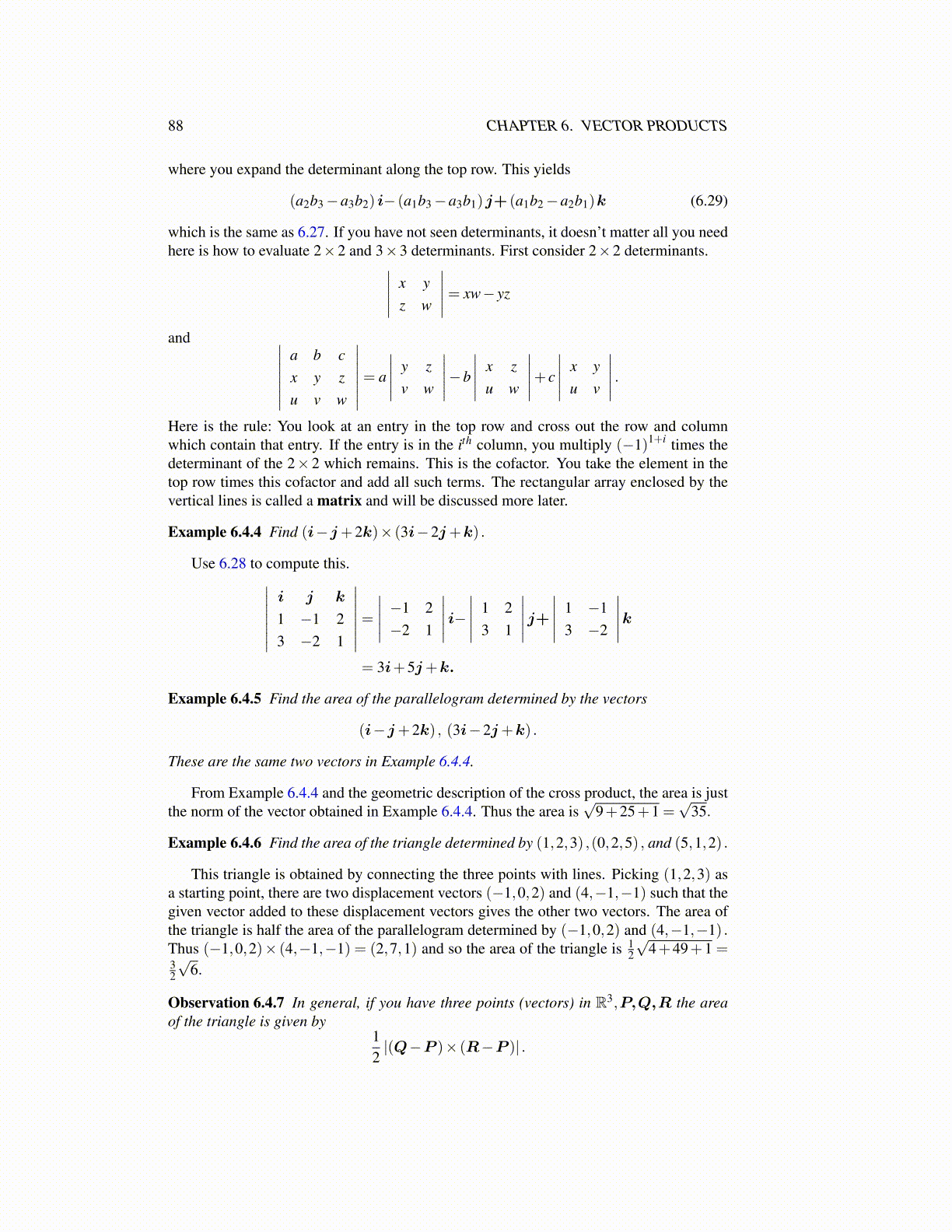
88 CHAPTER 6. VECTOR PRODUCTS
where you expand the determinant along the top row. This yields
(a2b3−a3b2) i− (a1b3−a3b1)j+ (a1b2−a2b1)k (6.29)
which is the same as 6.27. If you have not seen determinants, it doesn’t matter all you needhere is how to evaluate 2×2 and 3×3 determinants. First consider 2×2 determinants.∣∣∣∣∣ x y
z w
∣∣∣∣∣= xw− yz
and ∣∣∣∣∣∣∣a b cx y zu v w
∣∣∣∣∣∣∣= a
∣∣∣∣∣ y zv w
∣∣∣∣∣−b
∣∣∣∣∣ x zu w
∣∣∣∣∣+ c
∣∣∣∣∣ x yu v
∣∣∣∣∣ .Here is the rule: You look at an entry in the top row and cross out the row and columnwhich contain that entry. If the entry is in the ith column, you multiply (−1)1+i times thedeterminant of the 2× 2 which remains. This is the cofactor. You take the element in thetop row times this cofactor and add all such terms. The rectangular array enclosed by thevertical lines is called a matrix and will be discussed more later.
Example 6.4.4 Find (i−j+2k)× (3i−2j+k) .
Use 6.28 to compute this.∣∣∣∣∣∣∣i j k
1 −1 23 −2 1
∣∣∣∣∣∣∣=∣∣∣∣∣ −1 2−2 1
∣∣∣∣∣ i−∣∣∣∣∣ 1 2
3 1
∣∣∣∣∣j+∣∣∣∣∣ 1 −1
3 −2
∣∣∣∣∣k= 3i+5j+k.
Example 6.4.5 Find the area of the parallelogram determined by the vectors
(i−j+2k) , (3i−2j+k) .
These are the same two vectors in Example 6.4.4.
From Example 6.4.4 and the geometric description of the cross product, the area is justthe norm of the vector obtained in Example 6.4.4. Thus the area is
√9+25+1 =
√35.
Example 6.4.6 Find the area of the triangle determined by (1,2,3) ,(0,2,5) , and (5,1,2) .
This triangle is obtained by connecting the three points with lines. Picking (1,2,3) asa starting point, there are two displacement vectors (−1,0,2) and (4,−1,−1) such that thegiven vector added to these displacement vectors gives the other two vectors. The area ofthe triangle is half the area of the parallelogram determined by (−1,0,2) and (4,−1,−1) .Thus (−1,0,2)× (4,−1,−1) = (2,7,1) and so the area of the triangle is 1
2
√4+49+1 =
32
√6.
Observation 6.4.7 In general, if you have three points (vectors) in R3,P,Q,R the areaof the triangle is given by
12|(Q−P )× (R−P )| .